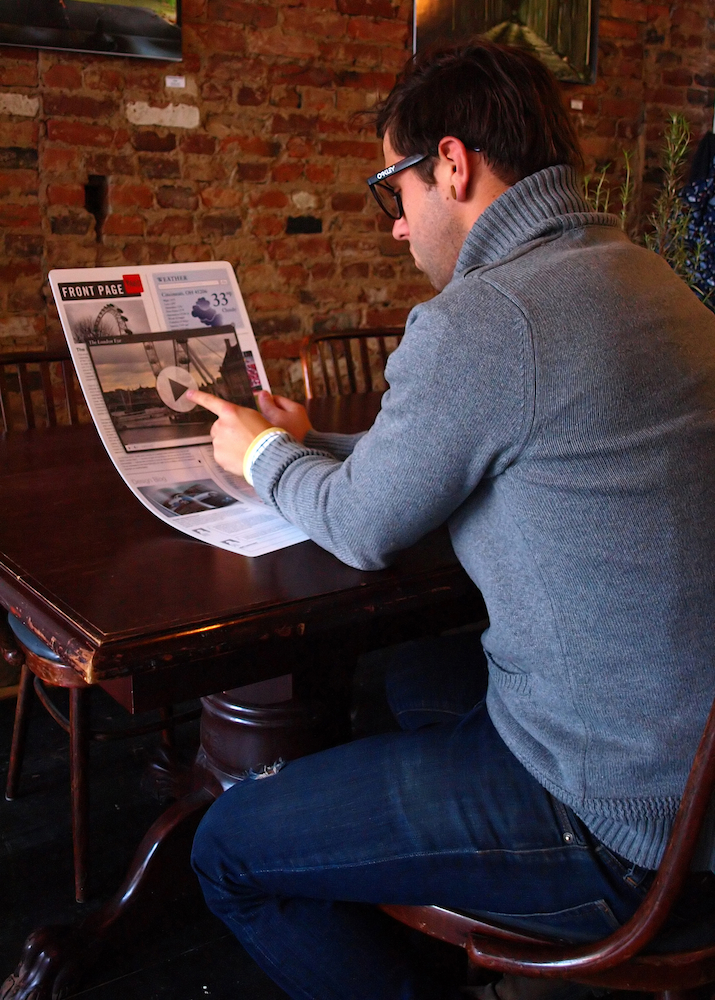New E-Reader Display Aims at Video and Color

A new prototype e-reader display offers a small window into the future of these evolving devices. It's able to show new pages quickly enough to play videos, and its white background is brighter than a magazine's white pages — an important component for making color e-readers, says the prototype's lead creator, engineer Jason Heikenfeld.
The prototype paves the way for e-readers that combine the best of readers and tablet computers, along with some abilities neither technology has. E-readers in the future could be very thin and light, show colors and videos, use little battery and be easy to read in sunlight, said Heikenfeld, who leads the Novel Devices Laboratory at the University of Cincinnati and conducts research for an e-reader display company, Gamma Dynamics. [SEE ALSO: Will Tablets Kill E-Readers?]
"If you want to make something like an iPad you can roll up and put in your pocket, this is the type of technology that can enable that type of breakthrough," Heikenfeld told TechNewsDaily.
The prototype Heikenfeld and his Cincinnati colleagues made would still need years of work before it shows up in a roll-able tablet. It usually takes years of continued research and funding from investors to turn a research advance into a consumer product, Heikenfeld said.
In a paper they published today (Oct. 30), Heikenfeld and his colleagues reported on their new display, which shows black-and-white images, is about 6 inches wide and has a resolution of 150 pixels per inch. The most basic Amazon Kindle and Barnes & Noble Nook display just fewer than 170 pixels per inch.
Whiter and faster
The new e-paper is made with a white, plastic sheet that's 10 times thinner than a sheet of paper. The plastic is coated with aluminum, to help it reflect light better, and it's pricked with pores that are invisible to the naked eye.
Get the world’s most fascinating discoveries delivered straight to your inbox.
To show text or images, the display pushes ink from behind the white sheet, through the pores and onto the front of the sheet. This type of movement is usually much faster than the technology that switches pixels between black and white in Kindles, Nooks and other e-readers on the market, Heikenfeld said. "You typically switch over a 100 times faster over similar distances," he said.
Heikenfeld's display is able to change what it shows about 67 times a second, which is fast enough for videos.
The aluminum-coated plastic sheet also better hides black ink behind it than current e-reader displays. That's the key to its brighter white background. Heikenfeld compared basic e-reader displays to thinly painted white walls that still show some of a darker paint job underneath. "If you have a black wall in your house and you want to paint it white, you know one coat won't do it," he said.
That bright white not only makes for a display that looks more like glossy magazine pages, it could help researchers create e-readers that show color. Of course, the liquid crystal displays on tablets already show color, but they do so by shining colored lights out of the screen. E-readers, on the other hand, create colors by reflecting incoming light. They use much less power, are easier to read in sunlight and are thinner than LCDs.
Adding color inks to e-readers darkens their displays, Heikenfeld explained. By making a whiter display to start with, the Novel Devices Lab's technology builds in a cushion for the darkening effects of color inks, he said.
"Now you're starting to capture a lot of the advantages you have in an iPad screen, but you can see in it in sunlight," Heikenfeld said.
Grayscale and color next
The Novel Devices Lab is now trying to show grayscale images using their new display tech, Heikenfeld said. Gamma Dynamics is working on displaying color.
Another important next step will be to make larger versions of the display. "Our goal is to make this on a roll. We're talking about a roll 8 to 12 inches wide," Heikenfeld said.
He and his colleagues published their work in the journal Nature Communications.
This story was provided by TechNewsDaily, sister site to LiveScience. You can follow TechNewsDaily staff writer Francie Diep on Twitter @franciediep. Follow TechNewsDaily on Twitter, or on Facebook.



